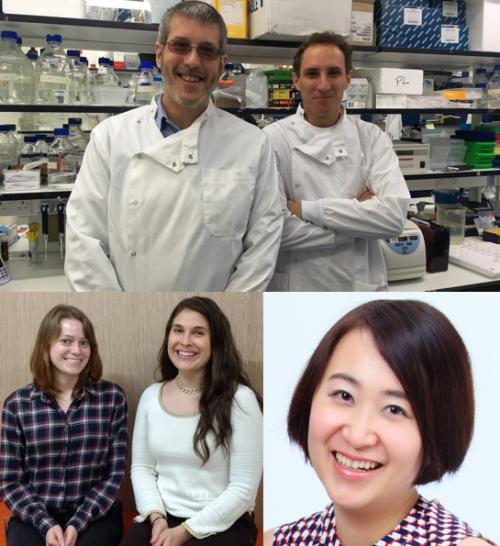
Mutations that activate the LRRK2 protein kinase, predispose to Parkinson’s disease, suggesting that LRRK2 inhibitors might have therapeutic benefit. Recent work has revealed that LRRK2 phosphorylates a subgroup of 14 Rab proteins, including Rab10, at a specific residue located at the centre of its effector binding Switch-II motif {see https://elifesciences.org/articles/31012}.
To analyse the activity of LRRK2 in vivo, it is essential to develop state of the art antibodies that robustly detect Rab proteins phosphorylated by LRRK2.
This proved very challenging, as stoichiometry of LRRK2 mediated phosphorylation of Rab proteins is low and typically less than 1% of the protein is phosphorylated. Moreover, the sequences surrounding the LRRK2 phosphorylation sites on Rab proteins are very similar making it very hard to raise sufficiently selective antibodies needed. This task is further complicated by at least 20 other Rab proteins being phosphorylated at the equivalent site by different kinases {see https://elifesciences.org/articles/31012}.
This explains why our initial efforts in raising antibodies that detect LRRK2 phosphorylated Rab proteins failed, as the affinity antibodies were unselective and also did not pick up LRRK2 phosphorylated Rab proteins.
The breakthrough came when Terina Martinez from the Michael J. Fox Foundation for Parkinson’s disease (MJFF) contacted us in the summer of 2016 and suggested that we raise rabbit monoclonal antibodies.
This resulted in Pawel Lis and Paul Davies (MRC-PPU), with great support and advise from Terina Martinez and Nicole K Polinski (MJFF) and a wonderful effort by Meng-Yun Chou and her team at Abcam, working together to raise rabbit monoclonal Phospho-specific antibodies that detect two of the major LRRK2 Rab substrates namely Rab8 (MJFF-pRAB8 antibody) and Rab10 (MJFF-pRab10 antibody).
For these projects, we also adopted a novel immunization strategy, in which each rabbit was immunized with two antigen phospho-peptides encompassing the Rab protein LRRK2 phosphorylation site, that possesses a Cys-aminohexanoic acid moiety either on its N-terminus or C-terminus.
The selectivity and sensitivity of these antibodies were painstakingly characterised by Pawel Lis in order to select the most potent and selective antibodies to take forward.
The MJFF-pRAB10 antibodies we developed are exquisitely selective for LRRK2 phosphorylated Rab10. These detect endogenous phosphorylated Rab10 in all analysed cell lines and tissues. These antibodies do not detect any other phosphorylated Rab protein (confirmed by using Rab10 knock-out A549 cells). We also found that the MJFF-pRAB10 antibodies can be deployed to assess enhanced Rab10 phosphorylation resulting from pathogenic (R1441C/G or G2019S) LRRK2 knock-in mutations as well as the impact of LRRK2 inhibitor treatment.
We also found that the MJFF-pRAB10 antibodies can be used to detect LRRK2 phosphorylated Rab10 in human brain. In collaboration with Janice Houlton (UCL) we obtained cingulate cortex samples from 23 controls and 28 idiopathic Parkinson’s patients and Sophie Burel, MRC-PPU postdoc, showed that levels of phosphorylated Rab10 were very low or non-detectable in the majority of samples apart from one idiopathic Parkinson’s with no known mutations.
In future work, it will be very exciting to employ this MJFF-pRAB10 antibodies technology, to study LRRK2 activity in different regions of the brain those from patients with LRRK2 pathogenic mutations.
Ying Fan (MRC-PPU Postdoc) and Esther Sammler (MRC-PPU & Neurologist consultant) also developed a new assay to measure LRRK2 activity in human neutrophils {see http://www.biochemj.org/content/early/2017/11/10/BCJ20170803}. This assay has potential to measure LRRK2 activity in humans for the first time.
The MJFF-pRAB8 antibodies are also very sensitive, but unlike the MJFF-pRAB10 antibodies are not selective and displayed broad specificity. Nevertheless, these antibodies are likely to be very useful, as they efficiently immunoprecipitate up to 9 of the 14 Rab proteins phosphorylated by LRRK2 (Rab3A, Rab3B, Rab3C, Rab3D, Rab8A, Rab8B, Rab10, Rab35 and Rab43). The MJFF-pRAB8 antibodies can therefore be utilised to immunoprecipitate a range of endogenous Rab proteins phosphorylated by LRRK2 from cells and tissues, which can then be detected with a total antibody.
The MJFF-pRAB8 and MJFF-pRAB10 antibodies will help with assessment of LRRK2 activity and examination of which Rab proteins are phosphorylated in vivo. These antibodies could also be used to assess impact of LRRK2 inhibitors in future clinical trials. These antibodies will be made commercially available by the MJFF and Abcam in the near future.
For more information regarding how to obtain these antibodies email tools@michaeljfox.org.
A series of other rabbit monoclonal antibodies detecting diverse LRRK2 phosphorylated Rab proteins and total Rab protein antibodies are also under development as a continuation of this collaboration. We are also evaluating whether these antibodies work in additional applications such as immunohistochemistry, enzyme-linked immunosorbent assay (ELISA) assay, and fluorescence-activated cell sorting (FACS).
To read the paper that describes the development of the MJFF-pRAB8 and MJFF-pRAB10 click here {http://www.biochemj.org/content/early/2017/11/10/BCJ20170802}.

